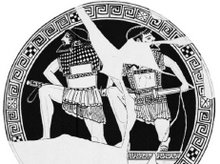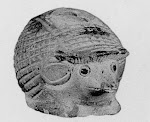I've just written a long article on the mechanics of hoplite battle for the Marathon Special issue of Ancient Warfare magazine (http://www.ancient-warfare.com/cms/ancient-warfare/guidelines/editorial-plan-2.html). I will be in good company, because the editors have secured articles by some of the top thinkers on ancient Greek warfare, like Krentz and Sekunda.
My article, which I think will have the final title, "The mechanics of hoplite combat: reconciling storm of spears with press of shields", is a bit over 6,000 words and crammed with many of the concepts I discuss on this blog. The goal of the article is to reconcile the increasingly divergent views of the "orthodox" and "heretical" views of hoplite combat. If you've been reading, then you know that I believe most of the differences evaporate once we understand the mechanics of masses of men in motion. The heretics in general don't understand how men could survive a physical push by all ranks, while the orthodoxy does not present realistic mechanics for men doing so. Were it not for the fact that they both veer away from their fields of expertise and into mine, I would have nothing to add to the discussion. But because they do, often making assertions that they are unqualified to make, I have an opportunity to bring about syncretism. To paraphrase Dr. Krentz, I have no expectation that my recommendations will be followed, but the argument should reach a larger audience now.
One thing that I have done in this article is to update the presentation of the crowd-othismos from my 2007 article. In that earlier article I specifically presented the new form of othismos as a counter to the prevailing orthodoxy. Because I wrote within the paradigm of the orthodoxy, the earlier article left the impression that battles had to start with a collision. In this article, I have shown what I have discussed on this blog for some time, that the physical collision of men more likely occurred after a period of spear-fighting. This is because the density of the crowd is far more important to the transmission of force than the speed of advance. Hence the storm of spears, then press of shields all formed part of the experience of most hoplite battles. Often, one side gave way "at spear's length" before othismos, and sometimes I believe there was an initial collision, as during the second phase of Coronea, "a battle like no other", but the threat of both phases of battle was always present.
I haven't posted for a while, but I have been banking up information. Once the article comes out, there will be a flurry of posts to provide supporting material. I have many diagrams I did for the article that will find their way into posts.
So, check back over the next month or so because things will heat up.
Wednesday, July 27, 2011
Subscribe to:
Posts (Atom)



